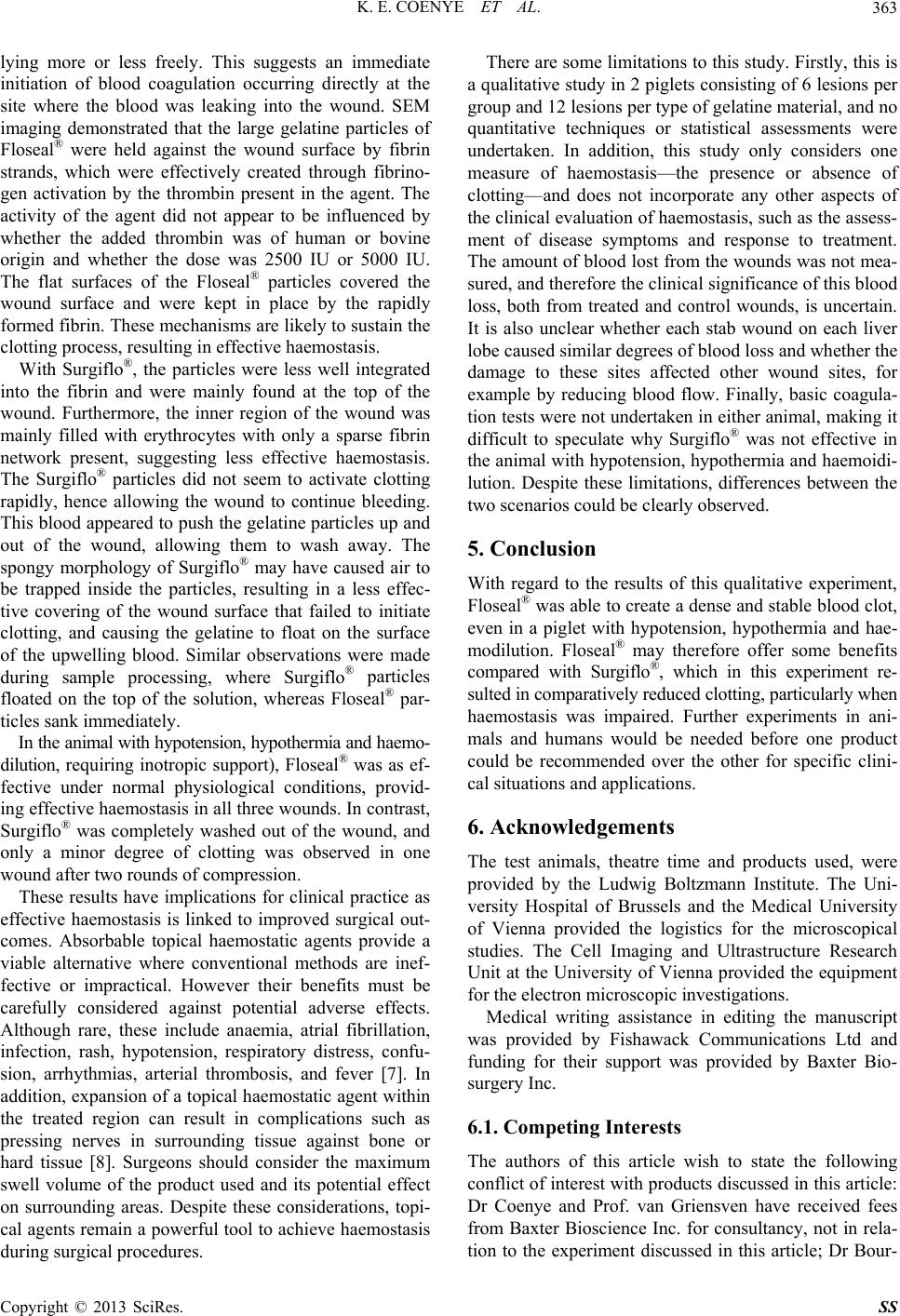
K. E. COENYE ET AL. 363
lying more or less freely. This suggests an immediate
initiation of blood coagulation occurring directly at the
site where the blood was leaking into the wound. SEM
imaging demonstrated that the large gelatine particles of
Floseal® were held against the wound surface by fibrin
strands, which were effectively created through fibrino-
gen activation by the thrombin present in the agent. The
activity of the agent did not appear to be influenced by
whether the added thrombin was of human or bovine
origin and whether the dose was 2500 IU or 5000 IU.
The flat surfaces of the Floseal® particles covered the
wound surface and were kept in place by the rapidly
formed fibrin. These mechanisms are likely to sustain the
clotting process, resulting in effective haemostasis.
With Surgiflo®, the particles were less well integrated
into the fibrin and were mainly found at the top of the
wound. Furthermore, the inner region of the wound was
mainly filled with erythrocytes with only a sparse fibrin
network present, suggesting less effective haemostasis.
The Surgiflo® particles did not seem to activate clotting
rapidly, hence allowing the wound to continue bleeding.
This blood appeared to push the gelatine particles up and
out of the wound, allowing them to wash away. The
spongy morphology of Surgiflo® may have caused air to
be trapped inside the particles, resulting in a less effec-
tive covering of the wound surface that failed to initiate
clotting, and causing the gelatine to float on the surface
of the upwelling blood. Similar observations were made
during sample processing, where Surgiflo® particles
floated on the top of the solution, whereas Floseal® par-
ticles sank immediately.
In the animal with hypotension, hypothermia and haemo-
dilution, requiring inotropic support), Floseal® was as ef-
fective under normal physiological conditions, provid-
ing effective haemostasis in all three wounds. In contrast,
Surgiflo® was completely washed out of the wound, and
only a minor degree of clotting was observed in one
wound after two rounds of compression.
These results have implications for clinical practice as
effective haemostasis is linked to improved surgical out-
comes. Absorbable topical haemostatic agents provide a
viable alternative where conventional methods are inef-
fective or impractical. However their benefits must be
carefully considered against potential adverse effects.
Although rare, these include anaemia, atrial fibrillation,
infection, rash, hypotension, respiratory distress, confu-
sion, arrhythmias, arterial thrombosis, and fever [7]. In
addition, expansion of a topical haemostatic agent within
the treated region can result in complications such as
pressing nerves in surrounding tissue against bone or
hard tissue [8]. Surgeons should consider the maximum
swell volume of the product used and its potential effect
on surrounding areas. Despite these considerations, topi-
cal agents remain a powerful tool to achieve haemostasis
during surgical procedures.
There are some limitations to this study. Firstly, this is
a qualitative study in 2 piglets consisting of 6 lesions per
group and 12 lesions per type of gelatine material, and no
quantitative techniques or statistical assessments were
undertaken. In addition, this study only considers one
measure of haemostasis—the presence or absence of
clotting—and does not incorporate any other aspects of
the clinical evaluation of haemostasis, such as the assess-
ment of disease symptoms and response to treatment.
The amount of blood lost from the wounds was not mea-
sured, and therefore the clinical significance of this blood
loss, both from treated and control wounds, is uncertain.
It is also unclear whether each stab wound on each liver
lobe caused similar degrees of blood loss and whether the
damage to these sites affected other wound sites, for
example by reducing blood flow. Finally, basic coagula-
tion tests were not undertaken in either animal, making it
difficult to speculate why Surgiflo® was not effective in
the animal with hypotension, hypothermia and haemoidi-
lution. Despite these limitations, differences between the
two scenarios could be clearly observed.
5. Conclusion
With regard to the results of this qualitative experiment,
Floseal® was able to create a dense and stable blood clot,
even in a piglet with hypotension, hypothermia and hae-
modilution. Floseal® may therefore offer some benefits
compared with Surgiflo®, which in this experiment re-
sulted in comparatively reduced clotting, particularly when
haemostasis was impaired. Further experiments in ani-
mals and humans would be needed before one product
could be recommended over the other for specific clini-
cal situations and applications.
6. Acknowledgements
The test animals, theatre time and products used, were
provided by the Ludwig Boltzmann Institute. The Uni-
versity Hospital of Brussels and the Medical University
of Vienna provided the logistics for the microscopical
studies. The Cell Imaging and Ultrastructure Research
Unit at the University of Vienna provided the equipment
for the electron microscopic investigations.
Medical writing assistance in editing the manuscript
was provided by Fishawack Communications Ltd and
funding for their support was provided by Baxter Bio-
surgery Inc.
6.1. Competing Interests
The authors of this article wish to state the following
conflict of interest with products discussed in this article:
Dr Coenye and Prof. van Griensven have received fees
from Baxter Bioscience Inc. for consultancy, not in rela-
tion to the experiment discussed in this article; Dr Bour-
Copyright © 2013 SciRes. SS